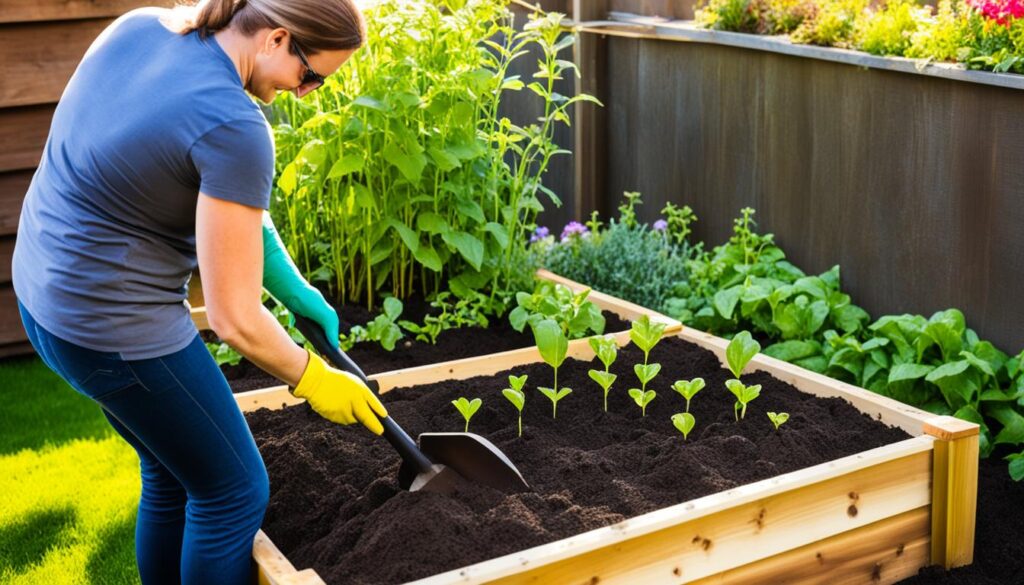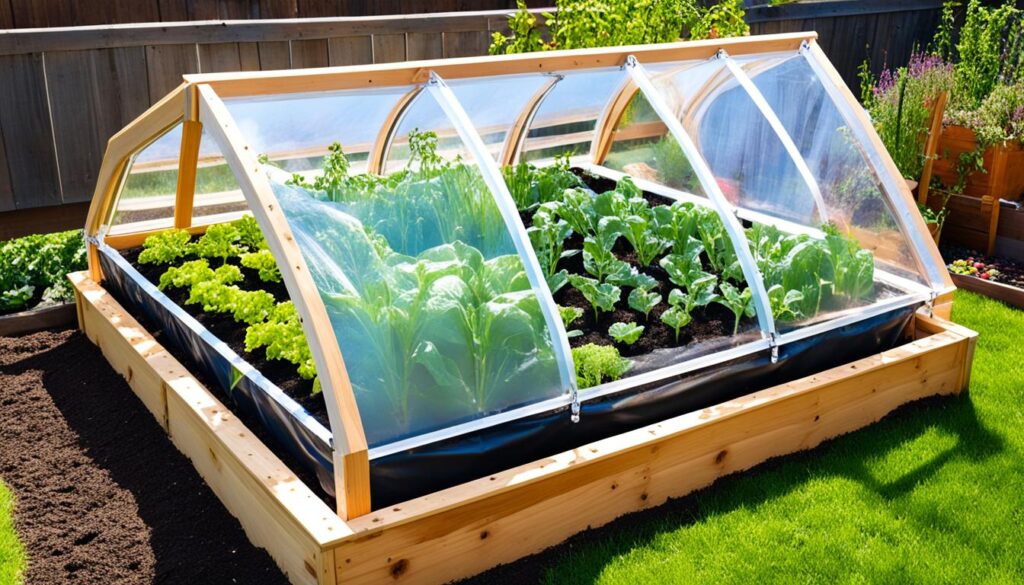Welcome to my guide on why hydrangea leaves may be turning brown and how you can remedy this common issue. Hydrangeas are beloved for their stunning blooms and vibrant foliage, but when those leaves start developing unsightly brown spots, it can be a cause for concern. Understanding the reasons behind this leaf discoloration and knowing how to address it will help you maintain the beauty and health of your hydrangea plants.
Key Takeaways:
- Hydrangea leaf discoloration, such as brown spots, is a common issue.
- Various factors, including environmental conditions, pests, and diseases, can contribute to brown hydrangea leaves.
- Proper care, such as providing adequate sunlight and water, can minimize leaf browning.
- Identifying and addressing pest infestations and fungal or bacterial diseases is crucial for maintaining leaf health.
- Regular maintenance, including pruning and soil management, can prevent and address leaf browning.
Common Causes of Hydrangea Leaf Browning
Brown leaves on your hydrangea can be a disheartening sight, but understanding the common causes behind this issue can help you address the problem effectively. From environmental factors to pests and diseases, several culprits can contribute to the browning of your hydrangea leaves.
Environmental Factors:
Hydrangeas are prone to leaf discoloration due to various environmental conditions. Hydrangea leaf problems can arise when the plants are exposed to excessive sunlight or extreme temperatures. Inadequate watering or improper drainage can also lead to brown spots on the leaves. It’s crucial to ensure that your hydrangeas have the right balance of sunlight, water, and temperature to keep their leaves healthy and vibrant.
Pests:
Pests can cause significant damage to hydrangea leaves, leading to browning and other issues. Common culprits include hydrangea leaf browning aphids, spider mites, and lace bugs. These pests feed on the plant’s sap, causing the leaves to wither and brown. Regular inspection and timely pest control measures can help prevent infestations and maintain the health of your hydrangeas.
Diseases:
Various fungal and bacterial diseases can affect the leaves of your hydrangeas, resulting in browning and discoloration. Some common hydrangea leaf diseases include powdery mildew, leaf spot, and leaf blight. These diseases usually thrive in damp conditions and can spread rapidly if not addressed promptly. Proper sanitation and the use of fungicides can help prevent and manage leaf diseases effectively.
Environmental Factors and Hydrangea Leaf Discoloration
When it comes to the health and appearance of your hydrangea plants, environmental factors play a crucial role. Sunlight, temperature, and water can all influence the color and overall condition of hydrangea leaves. By understanding and managing these factors, you can minimize leaf discoloration and ensure your plants thrive.
Sunlight: Hydrangeas require the right amount of sunlight to maintain vibrant foliage. While they prefer partial shade, some varieties can tolerate full sun. Too much direct sunlight can lead to leaf scorching and discoloration, especially during hot summer months. On the other hand, inadequate sunlight can cause weak growth and pale leaves. Find a suitable balance and provide your hydrangeas with the appropriate amount of light to promote healthy leaf development.
Temperature: Hydrangeas are sensitive to extreme temperatures, and fluctuations can impact leaf color. Hot and dry conditions can cause leaves to wilt, turn brown, or develop a scorched appearance. In contrast, frost or cold snaps can lead to leaf damage, discoloration, and even dieback. Pay attention to the temperature requirements of your specific hydrangea variety and provide protection during temperature extremes to prevent leaf issues.
Water: Adequate hydration is essential for maintaining lush hydrangea leaves. Overwatering can result in root rot and promote leaf discoloration, while underwatering can cause wilting, browning, and crispy foliage. Strike a balance by watering your hydrangeas consistently, ensuring the soil remains moist but well-drained. Avoid waterlogged conditions and consider using mulch to help retain moisture and regulate soil temperature.
Proper Hydrangea Care Tips:
- Plant hydrangeas in areas with the appropriate light conditions for their specific variety.
- Protect hydrangeas from intense midday sun, especially during hot summer months.
- Provide shade or use shade cloth to shield hydrangeas from direct sunlight if necessary.
- Monitor temperature fluctuations and take steps to protect hydrangeas during extreme weather conditions.
- Water hydrangeas regularly, keeping the soil consistently moist but not waterlogged.
- Apply mulch around the base of the plants to retain moisture, regulate temperature, and prevent weeds.
By managing environmental factors such as sunlight, temperature, and water, you can help prevent leaf discoloration and promote the overall health and beauty of your hydrangea plants.

Pest Infestations and Hydrangea Leaf Problems
Hydrangea leaf problems can often be caused by pest infestations, which can lead to brown spots and damage on the leaves. Identifying and addressing these infestations is crucial to protect your plants and ensure their health and vitality.
One common pest that affects hydrangeas is the aphid. These tiny insects can suck sap from the leaves, causing them to wilt, curl, and develop brown spots. Another culprit is the spider mite, which feeds on the plant’s juices and creates webbing on the leaves.
To identify pest infestations, examine the undersides of the leaves for signs of small insects, webbing, or eggs. You may also notice distorted or discolored leaves as a result of the damage. It’s important to take action promptly to prevent the pests from spreading and causing further harm.
There are several methods you can use to address pest infestations on hydrangea plants. One natural approach is to spray the leaves with a mixture of water and mild soap, which can help reduce the population of pests. For severe infestations, you may need to use insecticidal soap or horticultural oil, following the product instructions carefully.
It’s also important to practice good hygiene in your garden to prevent pest infestations. Remove any fallen leaves or plant debris from the area to eliminate hiding places for pests. Additionally, avoid overwatering your hydrangeas, as damp conditions can attract certain pests.
Regularly inspecting your plants and taking proactive measures to address pest infestations is key to maintaining the health and beauty of your hydrangeas. By incorporating these care tips into your gardening routine, you’ll be able to enjoy vibrant and thriving hydrangea plants all season long.
Fungal and Bacterial Diseases Affecting Hydrangea Leaves
When it comes to the health of your hydrangea plants, fungal and bacterial diseases can be a major concern. These diseases can manifest as brown patches or discoloration on the leaves, affecting the overall beauty and vitality of your plants. In this section, I will provide valuable information on preventing and treating these diseases, helping you keep your hydrangeas healthy and vibrant.
Fungal Diseases:
 Fungal diseases like powdery mildew, leaf spot, and botrytis blight can wreak havoc on your hydrangea leaves. Powdery mildew appears as a white, powdery coating on the leaves, while leaf spot presents itself as dark spots or lesions. Botrytis blight, on the other hand, causes grayish-brown patches on the leaves and petals. To prevent fungal diseases, it is essential to promote good air circulation by providing adequate spacing between plants. Regularly inspecting your plants for early signs of disease and promptly removing any infected leaves can help prevent the spread. Applying a suitable fungicide can provide additional protection against fungal diseases.
Fungal diseases like powdery mildew, leaf spot, and botrytis blight can wreak havoc on your hydrangea leaves. Powdery mildew appears as a white, powdery coating on the leaves, while leaf spot presents itself as dark spots or lesions. Botrytis blight, on the other hand, causes grayish-brown patches on the leaves and petals. To prevent fungal diseases, it is essential to promote good air circulation by providing adequate spacing between plants. Regularly inspecting your plants for early signs of disease and promptly removing any infected leaves can help prevent the spread. Applying a suitable fungicide can provide additional protection against fungal diseases.
Bacterial Diseases:
Bacterial leaf spot and bacterial wilt are common bacterial diseases that affect hydrangea leaves. Bacterial leaf spot appears as small, water-soaked spots that can enlarge and turn brown. This disease spreads through water splashes and can be kept under control by avoiding overhead watering, removing and destroying infected leaves, and applying a copper-based spray. Bacterial wilt, on the other hand, causes wilting and eventual death of the entire plant. Unfortunately, there is no cure for bacterial wilt, and infected plants should be promptly removed to prevent the spread to other healthy plants.
By practicing good hygiene, such as cleaning and sanitizing tools, and promoting optimal growing conditions for your hydrangeas, you can significantly reduce the risk of fungal and bacterial diseases. Additionally, providing proper care, including regular watering, adequate sunlight, and balanced fertilization, will help strengthen your plants’ immune system and make them more resistant to these diseases.
Remember, prevention is key when it comes to keeping your hydrangeas healthy and free from diseases. Regular monitoring and taking prompt action at the first sign of trouble can go a long way in protecting the beauty and longevity of your beloved hydrangea plants.
Proper Hydrangea Care to Prevent Leaf Browning
When it comes to preventing leaf browning in hydrangeas, proper care is key. By following a few essential tips and practices, you can ensure that your hydrangea plants stay vibrant and healthy. From watering and fertilizing to pruning and soil management, here’s everything you need to know:
- Watering: Hydrangeas need regular and consistent watering to thrive. Provide them with deep watering sessions rather than frequent shallow watering. This helps the roots receive sufficient moisture while preventing waterlogged soil, which can lead to leaf browning. Remember to water at the base of the plant, avoiding the foliage, to minimize the risk of fungal diseases.
- Fertilizing: Feed your hydrangeas with a balanced fertilizer specifically formulated for acid-loving plants. Apply it according to the package instructions to provide the necessary nutrients for healthy growth. Avoid overfertilizing, as excessive nitrogen can cause leaf browning. Regularly mulching around the base of the plant can also help conserve moisture and add nutrients to the soil.
- Pruning: Pruning plays a crucial role in maintaining the shape and health of your hydrangea plants. Remove any dead, damaged, or diseased branches to prevent the spread of pathogens. Additionally, prune selectively to promote air circulation, which helps prevent fungal diseases that can cause leaf browning. Each hydrangea variety may have different pruning requirements, so consult specific guidelines for your plant.
- Soil Management: Hydrangeas thrive in well-draining, fertile soil. Ensure that the soil has good drainage to prevent waterlogged conditions that can lead to root rot and leaf browning. Consider amending heavy clay soils with organic matter, such as compost or well-rotted manure, to improve drainage and enhance nutrient availability.
Remember to monitor your hydrangea plants regularly for any signs of leaf browning. Early detection can help you address issues promptly and prevent further damage. By implementing these care tips and practices, you’ll enjoy vibrant and healthy hydrangeas, free from unsightly brown leaves.
Troubleshooting Common Hydrangea Leaf Issues
If you’ve noticed issues with your hydrangea leaves, including wilting, curling, or discoloration, don’t worry! I’m here to help you troubleshoot and find solutions to these common problems.
1. Wilted Leaves
Wilted hydrangea leaves are often a sign of dehydration. Make sure your plants are receiving adequate water. Check the soil moisture regularly and water deeply when the top inch of soil feels dry. Avoid overwatering, as it can lead to root rot and other issues.
2. Curling Leaves
Curling leaves can indicate various problems, including extreme heat, low humidity, or pest infestations. Provide shade during hot summer afternoons and ensure the soil is consistently moist. To combat pests, such as aphids, use organic insecticidal soap or neem oil.
3. Discolored Leaves
Discoloration of hydrangea leaves, especially browning, can be caused by several factors. One common cause is nutrient deficiency. Consider using a slow-release balanced fertilizer to replenish essential nutrients. Also, check the pH level of the soil, as it can affect nutrient availability.
Another possible cause of leaf discoloration is sunburn. If your hydrangeas are exposed to direct sunlight for prolonged periods, move them to a spot with partial shade. This will help prevent leaf scorch and maintain their vibrant color.

By following these troubleshooting tips and remedies, you can identify and address the leaf issues affecting your hydrangea plants. Remember to consistently monitor their condition and make adjustments to their care as needed. With proper attention and care, your hydrangeas will thrive and reward you with beautiful, healthy leaves.
Restoring the Beauty of Brown Hydrangea Leaves
If you’ve noticed that your hydrangea leaves have turned brown, don’t worry – there are remedies and treatments available to help restore their health and vibrant color. Follow these step-by-step instructions and recommendations to rejuvenate your plants and bring them back to their former beauty.
1. Identify the Cause
Before proceeding with any treatments, it’s important to determine the underlying cause of the brown leaf discoloration. Environmental factors such as excessive sunlight, extreme temperatures, or improper watering may be to blame. Additionally, pest infestations or fungal and bacterial diseases can also lead to leaf browning.
2. Adjust Environmental Conditions
If environmental factors are causing the brownness of your hydrangea leaves, make the necessary adjustments. Provide shade during the hottest parts of the day, ensure consistent moisture levels by watering regularly, and protect your plants from harsh winds or frost.
3. Combat Pests
If pests are responsible for the browning of your hydrangea leaves, identify the specific pest and take appropriate measures. Use organic insecticides or natural repellents to control the infestation and protect your plants from further damage.
4. Treat Fungal and Bacterial Diseases
If fungal or bacterial diseases are affecting your hydrangea leaves, use fungicides or bactericides recommended for hydrangeas. Follow the instructions carefully and treat your plants accordingly to stop the disease from spreading.
5. Prune and Remove Affected Leaves
To promote healthy leaf growth, prune any dead or diseased parts of your hydrangea plants. Be sure to remove the affected leaves carefully and dispose of them properly to prevent the spread of pests or diseases.
Remember to clean your pruning tools thoroughly between each cut to avoid cross-contamination.
6. Provide Proper Care
To prevent future leaf browning, continue to provide proper care for your hydrangea plants. This includes regular watering, fertilizing with a balanced hydrangea-specific fertilizer, and maintaining good soil drainage. Avoid overwatering or underwatering, as both can contribute to leaf discoloration.
Monitor your plants closely and make adjustments to their care regimen as needed. Regularly inspect your hydrangeas for signs of pests or diseases and take immediate action to address any issues that arise.
By following these remedies and treatments, you can restore the health and beauty of your brown hydrangea leaves, allowing your plants to thrive and bloom once again.
Maintaining Healthy Hydrangea Plants for Luscious Blooms
Now that you have learned how to identify and address brown hydrangea leaves, it’s time to focus on long-term care to ensure your plants continue to thrive and produce luscious blooms. By following these hydrangea care tips, you can maintain the health and beauty of your plants for years to come.
Firstly, it’s essential to provide your hydrangeas with the right amount of water. Aim for consistent moisture without waterlogging the soil. Regular watering, especially during dry periods, will help prevent leaf browning and maintain hydration in the plant.
In addition to watering, proper fertilization is crucial for healthy growth. Apply a balanced, slow-release fertilizer specifically formulated for hydrangeas in early spring. This will provide the necessary nutrients for robust foliage and vibrant blooms. Remember to follow the package instructions and avoid over-fertilization, as excessive nutrients can lead to leaf burn.
Lastly, regular pruning and deadheading will promote new growth and prevent disease. Remove any dead or damaged branches to encourage airflow and reduce the risk of infections. Deadheading spent flowers will redirect the plant’s energy towards new blooms, keeping your hydrangeas looking fresh and vibrant.
By incorporating these hydrangea care tips into your gardening routine, you can keep your plants healthy and prevent brown leaf discoloration. With proper care, your hydrangeas will reward you with an abundance of beautiful blooms, creating a delightful display in your garden.








